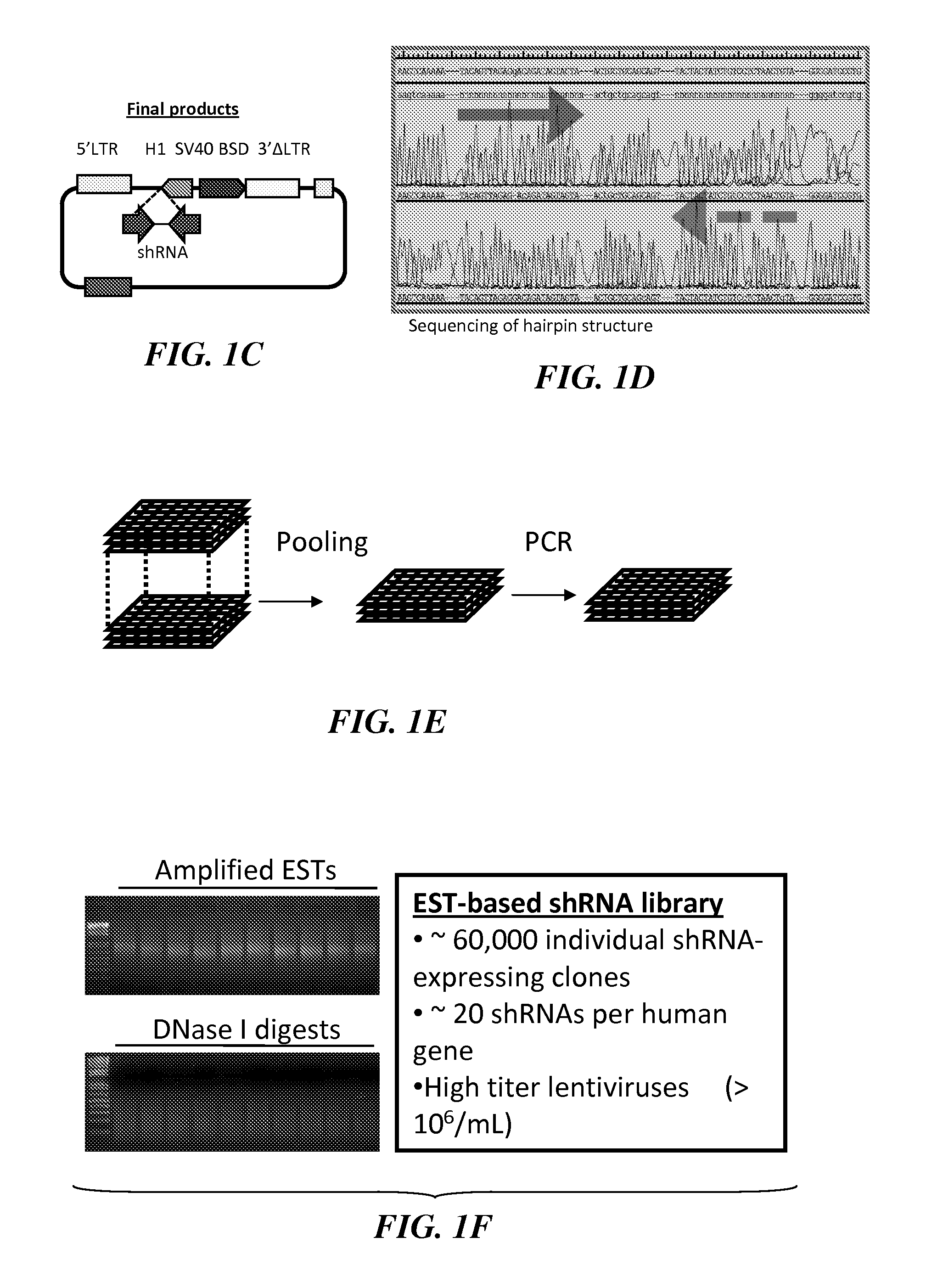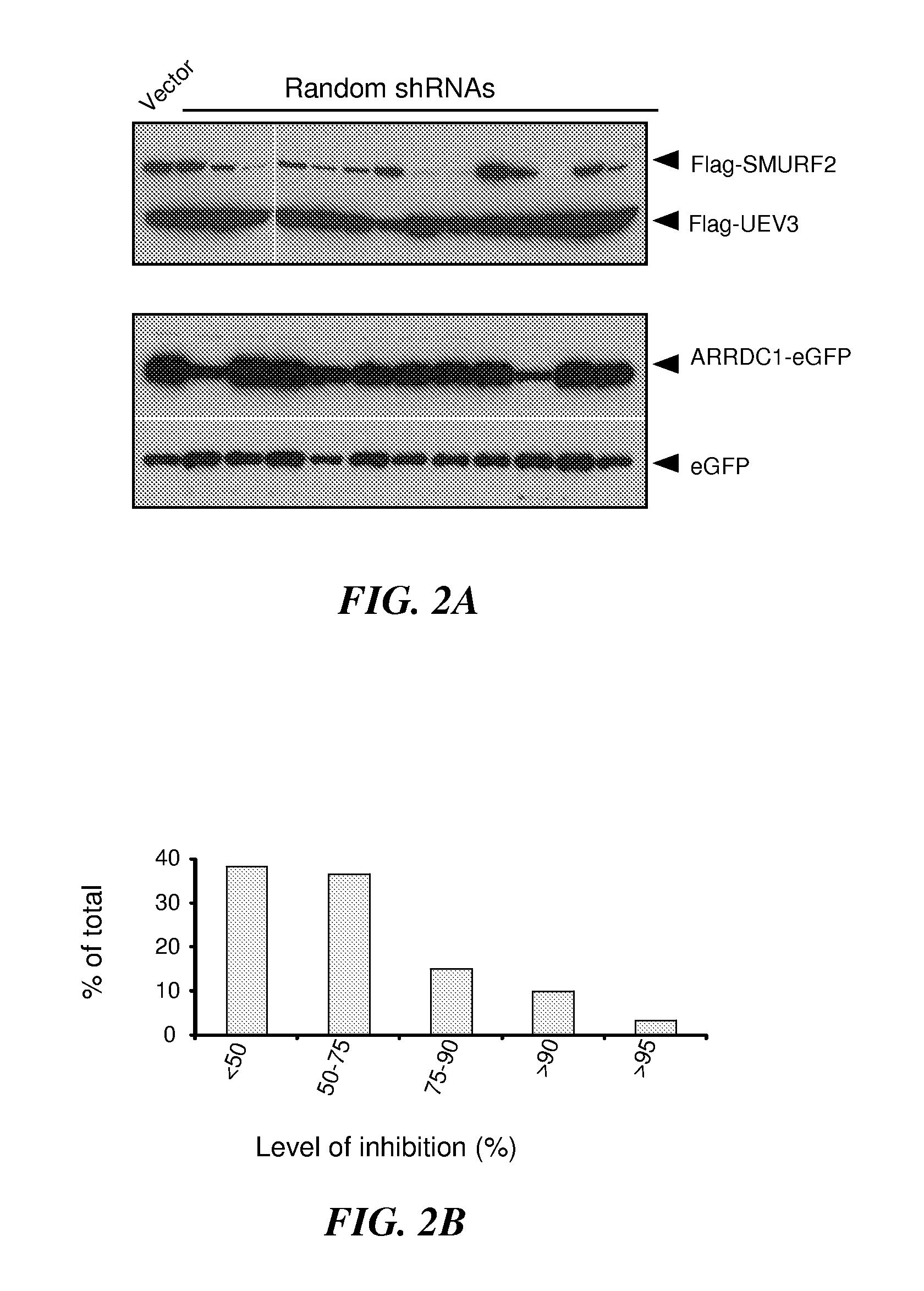Methods and compositions for inhibition of beta2-adrenergic receptor degradation
- Summary
- Abstract
- Description
- Claims
- Application Information
AI Technical Summary
Benefits of technology
Problems solved by technology
Method used
Image
Examples
example 1
Development of a Novel shRNA Library Derived from ESTs
[0331]Until recently, characterization of gene functions required laborious, individually focused investigation. Current developments in genome-wide RNAi screens allow discovery of candidate genes of essential functions in both physiological and pathological functions. While widely used, current RNAi methods have their own drawbacks. One type of most common RNAi libraries use chemically synthesized DNA oligonucleotides on expression vectors to express short hairpin RNAs (shRNAs). Construction of such libraries is laborious, costly, and error-prone. Moreover, the resulting libraries often contain a limited number of targeting shRNAs (usually 3-5) for each single gene. The targeting shRNA sequences are usually chosen based on computer algorithms that predict the knockdown efficiency of shRNAs. These algorithms vary in sequence prediction and are far from perfect. Thus, many of the genes in those libraries may not have effective tar...
example 2
Genome-Wide Screen for Genes Regulating Agonist Induced Internalization of β2AR
[0336]Herein, the inventors demonstrate the establishment of a robust assay system to identify target genes which serve as β2-AR regulator genes, and where modulation (e.g., inhibition or activation) of such β2-AR regulator genes serves to prevent β2-AR degredation.
[0337]Most in vitro cell lines expressing β2AR exhibit slow receptor degradation. For example, in most cell culture models, including cells expressing exogenous β2AR, β-agonist stimulation leads to a very modest reduction in the receptor protein level (Liang, 2003; Moore, 1999). The slow degradation is attributed to quick recycling of the receptor back to the cell surface after internalization (Cao, 1999; Gage, 2001; Hanyaloglu, 2007; Xiang, 2003). Von Zastrow and colleagues found that modifications of β2AR at the C-terminus interfere with the recycling process and result in much faster receptor degradation upon agonist stimulation (Gage, 2001;...
example 3
FDP Synthase Regulates the Amount of Cell Surface NAR
[0353]To confirm the inhibitory effect of FDPS-targeting shRNA on agonist induced β2AR internalization, the inventors re-transduced the shRNA back to 293β2AR* cells. Immunoblot analysis showed increased amount of β2AR in FDPS-specific shRNA transduced cells after 3 hours of agonist induction as compared to empty vector transduced cells (FIG. 4A). RNAi technology is known to have potential side effects caused by imperfect match to non-target sequences. To limit such side effect, the inventors used a synthetic siRNA for FDPS with different sequence to the shRNA we had isolated. The FDPS-specific siRNA down regulated the mRNA level of FDPS efficiently by about 80%, while the shRNA had only about 10% efficiency (FIG. 4B). Functionally, FDPS-specific siRNA transfected 293.β2AR* cells showed about 2-fold increase in cell surface β2AR both prior and post agonist induction as compared to non-targeting control siRNA transfected cells (FIG....
PUM
| Property | Measurement | Unit |
|---|---|---|
| Fraction | aaaaa | aaaaa |
Abstract
Description
Claims
Application Information
 Login to View More
Login to View More - R&D
- Intellectual Property
- Life Sciences
- Materials
- Tech Scout
- Unparalleled Data Quality
- Higher Quality Content
- 60% Fewer Hallucinations
Browse by: Latest US Patents, China's latest patents, Technical Efficacy Thesaurus, Application Domain, Technology Topic, Popular Technical Reports.
© 2025 PatSnap. All rights reserved.Legal|Privacy policy|Modern Slavery Act Transparency Statement|Sitemap|About US| Contact US: help@patsnap.com



